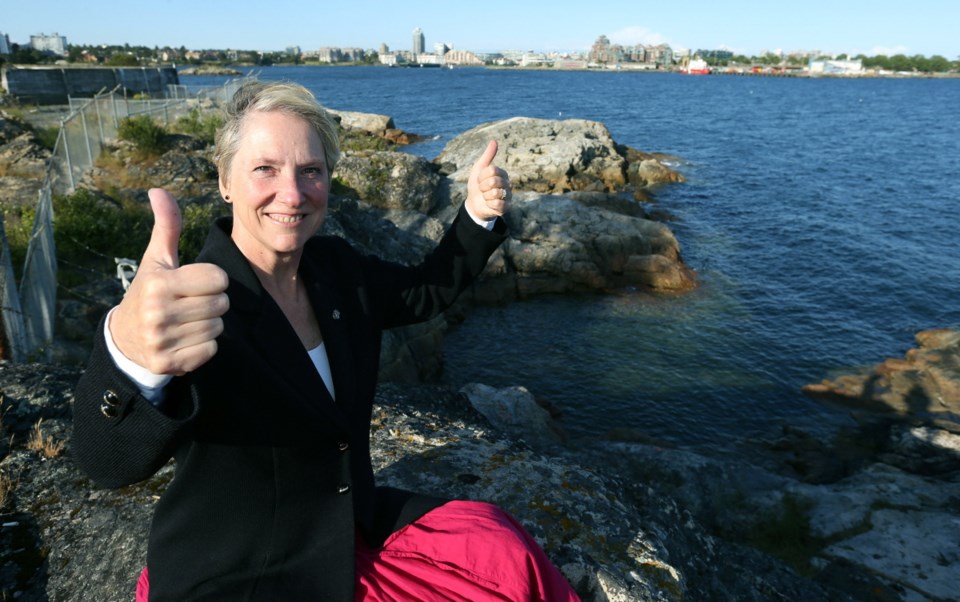The Capital Regional District will take a second look at how much it is collecting in taxes for sewage treatment until it has a better handle on what it plans to build.
“I think it’s prudent to say where are we? Where are we going? And what’s the best way to get there, while keeping it affordable at the same time,” said Victoria Mayor Lisa Helps, who chairs the CRD’s core area liquid waste management committee.
Projecting that eventual debt and operating costs for sewage treatment would total about $35 million a year, the CRD decided in February 2013 to begin collecting taxes in advance to soften the blow to taxpayers once it was built.
The idea was to have annual increases of $5 million, ramping up to the total projected $35-million annual cost at program completion.
But those estimates were for a single regional treatment plant to be built at McLoughlin Point. That plan went off the rails last year, when Esquimalt refused to rezone the site and the province declined to overturn the decision. Now the search is on for one or more sites for treatment that can be approved by June.
CRD directors decided Wednesday that, until a new plan is developed, it’s time to take a second look at how much money is being collected.
“The reality is that right now we’re collecting money from people when we don’t have a plan and we don’t know the cost. The reality of that is that is very unfair,” said Esquimalt Mayor Barb Desjardins.
“It’s like saying, ‘I don’t know what car I’m going to buy, but I’m going to make you help me pay for it now.’ ”
A better sense of potential costs will be developed as the year progresses and the Westside and Eastside subcommittees develop their sewage-treatment plans, she said.
At some point, taxpayers should be “gradually introduced” to the additional fees they will be paying for sewage treatment, but a review now provides an opportunity for a “sober second look,” said Victoria Coun. Marianne Alto.
“I also am very hopeful that as we take this new approach … that some of those options may in fact be less costly,” she said.
As the CRD budget is already set, any tax reduction won’t kick in until next year. CRD staff have been directed to review the sewage levy with a view to modifying it in time for the 2016 taxation year.
Last month, Langford Mayor Stew Young, in a move supported by the Westside sewage subcommittee, wrote to the CRD asking that the tax levies for the program be put on hold until a preferred site is identified and secured, and reasonably reliable cost estimates have been developed.
There is also growing frustration that the independent Seaterra commission is still racking up expenses while the planned treatment plant at McLoughlin is dead. Some $60 million has already been invested in the former plan.
A petition signed by several local business owners called for Seaterra to be ended, saying it “has already left an expensive and embarrassing legacy for the region’s taxpayers.”
“What concerns me is it’s basically lost money. It’s not going to be found again,” said businessman Bill Beadle.
Helps noted that establishment of an independent commission to oversee the sewage project was a condition of provincial funding.
“There is growing frustration and part of it is because we’ve spent $60 million and don’t have a thing to show for it. Not all of that can be laid at the feet of Seaterra, but certainly there are some things that can,” Helps said.
The CRD’s sewage-treatment project has a budget of $788 million. The federal and provincial governments are to contribute two-thirds of the cost, and the remainder would come from local taxpayers.
If strict deadlines are not met, the CRD risks losing federal and provincial funding.
Underscoring how tight time is, Helps on Wednesday handed out to each director copies of the timeline that had been laminated into placemats.
“It is about federal funding but it is also about proving to ourselves and to the region and to everybody who is watching us across the region and around the world that we can actually do this,” she said.


